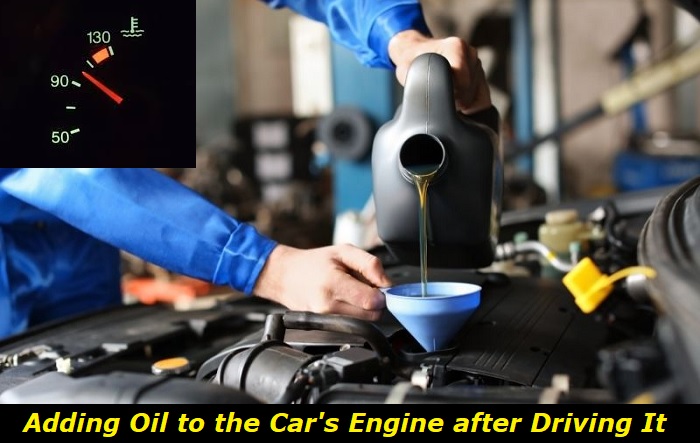It is good to note that the general rule is that you should wait 3- 5 minutes before you put oil in your car.
Oil level problems highlights
- Level of urgency:medium
- Average mileage:not related to mileage
- Repair cost:$5 - $550
- DIY repair:yesbutmaybe complicated
- Commonreasons:overfilled oil, coolant leaking into oil, gas leaking into oil
- If ignored:fatal engine damage, catalytic converter damage
- How to solve:add oil or pump it outdependingon the nature of the problem

Adding Oil to Your Car after Driving It
Due to the moving parts and internal combustion, your car will be heated after you drive it. It is, therefore, not advisable to fix some issues immediately after you switch off the car's engine. By taking precautions and taking some time to assess the issue, you will avoid causing damage to your car.
The following are some issues that can occur when you add oil to your car after driving it:
- Oil leaks, in case the engine is full.
- Poor oil pumping, in case the oil becomes sludge-like.
- Oil starvation.
- Engine damage.
Indications of Low Oil Levels
Aside from checking the display on the dashboard, the following are some of the indications that your car has low oil levels:
- Strange noises from your engine.
- A smoking or shaking car.
- Dirty and/or dark oil.
- A burning smell that originates from the engine.
Checking Your Car's Oil Level
The basic way of knowing a car's oil level is by checking the display on the dashboard. In most cars, there is a display to show when your car is due for an oil change. An oil dipstick is used to check the oil levels in a car.
The oil dipstick is usually brightly colored with a circular or hook-shaped handle. It is often placed near the oil fill cap, which is on top of the engine. The oil fill port is usually pictured with a small image and labeled 'Oil'.
To check the oil level using the dipstick, do the following:
- Pull out the dipstick and wipe it clean.
- Insert and pull out the dipstick.
- Check the oil level. It should be between the "full" and "low" marks on the dipstick.
When you pull the dipstick out, you should wipe it with a dry cloth. You can dip it back so as to get a more accurate reading.
You need to get the right amount of oil added to your car. If you put in too much or too little oil, you can end up causing engine damage. Too little oil, leads to poor lubrication for the engine, leading to it overheating.
When excessive oil is added, this oil will make its way into the combustion chamber. It will lead to low oil levels as it will be burned along with the fuel. This eventually causes engine seizures.
By doing the oil level check, you are able to estimate the amount that you need to top up. It is advisable that you add the oil in small volumes so as to avoid overfilling.
Understanding the Dipstick Appearance
Aside from the oil levels, you are able to get an indication of your car's health through the appearance of the dipstick. The following are some of the conditions that the dipstick appearance relay, and the actions that you need to take:
- Oil that is dirty or with a sludge-like appearance is an indication that an oil change is due.
- Oil that has metallic particles or debris in it means that you should seek the services of a mechanic.
- Milky or white oil indicates a coolant leak. For this, you need to get immediate assistance and tow your car to a mechanic.
Basic Tips to Follow When Adding Oil
As soon as you detect that your car has low oil levels, slow down and stop at a safe place. When adding oil to your car, the following are some of the basic tips to follow:
1) Safety First
It is always advisable to take precautions at all times. As you will be handling the engine area, please keep open flames away. It is also best to allow the engine to cool first before you add oil.
2) Use the Right Oil
Check your car's manual to get the information on the right type of oil to use for your car. You can also get advice from an expert. Do not switch from the recommended oil, especially if it is an old car.
Stick to the right oil as an attempt to switch to a different oil while seeking better performance may bring about issues. Check its viscosity and if it meets the standard requirements. For high-end cars or during extreme weather, synthetic oil is the best option.
3) Add the Right Amount of Oil
After checking the oil levels, you will have an idea of the amount of oil that you need to add. Add the right amount of oil. By adding too much or too little of the oil, you will have engine issues.
4) Check the Oil Levels at the Right Time
To get an accurate measure of the oil levels, check your oil levels at the right time. This is usually after 3- 5 minutes after you stop the car engine.
If you check the oil in your car after driving it without letting it rest first, you will possibly get an inaccurate reading. This is because some oil will still be at the top of the engine.
5) Avoid Spills
To avoid the oil from spilling, you can use a funnel. It is also advisable to add the oil in small volumes so as to avoid an instance of overfilling.
6) Keep the Car on Level Ground
It is best to check and add the oil to your car when it is on a level surface. Any slant or elevation will lead to inaccurate readings and the wrong amount of oil being added.
7) Take Action and Get Assistance
While it is possible to keep driving after you realize that you have low oil levels, it is advisable that you stop driving the car. Assess the situation and if it is not an issue that you can fix, get assistance from an expert.
Low Oil Pressure
Low oil pressure is another oil issue that you may encounter. A light usually comes on at the dashboard to indicate this issue. Low oil pressure is caused by an oil pump issue, dirty oil, or low oil levels.
It is advisable that you seek assistance from an expert in case the oil indicator does not go away. They will be able to narrow down the issue and help you in fixing it.
Why a Car May Not Start After Adding Oil
You may have added oil to your car but it fails to start after doing so. The following are some of the reasons why this may happen:
- The oil is too viscous (thick) and not flowing well.
- The wrong type of oil was added.
- Leaking from the head gasket may have caused the coolant to seep in.
- A blockage may have been caused by moisture that freezes in the fuel lines.
How Frequent Should Oil Changes Be?
Be sure to check your car's manual so as to check the recommendation. While most experts recommend it to be after every 8,000 miles, it could range between 3,000 miles and 15,000 miles. To get the recommended mileage, check your car's manual.
In terms of duration, it is advisable that you do an oil change every 6 to 12 months. However, note that it shall be whichever comes first: the duration passing or the mileage covered before you do the oil change.
If you travel long distances frequently, it is advisable that you have more frequent oil level checks. If you find yourself adding the oil too frequently, this may be an indication that you have an oil leak.
Conclusion
To avoid things going wrong when adding oil to your car, get it all right. Get the timing right and wait for 3- 5 minutes. You will also get to add the right amount of oil as the temperature will be normal.
Use the right type and amount of oil to care for the engine. Proper care and maintenance of your car will lengthen the useful life of the engine. By getting it all right when it comes to doing an oil change, you will not spoil your car.
About the authors
The CarAraC research team is composed of seasoned auto mechanics and automotive industry professionals, including individuals with advanced degrees and certifications in their field. Our team members boast prestigious credentials, reflecting their extensive knowledge and skills. These qualifications include: IMI: Institute of the Motor Industry, ASE-Certified Master Automobile Technicians; Coventry University, Graduate of MA in Automotive Journalism; Politecnico di Torino, Italy, MS Automotive Engineering; Ss. Cyril and Methodius University in Skopje, Mechanical University in Skopje; TOC Automotive College; DHA Suffa University, Department of Mechanical Engineering






Add comment